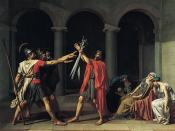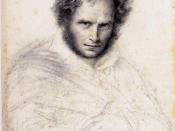Before the French Revolution artistic themes were commonly associated with political theories and the male body. They represented classic Roman virtues such as the civic trait of self-sacrifice, suppression of emotion, devotion to public duty, honesty and austerity.
A classic example is Jacques-Louis David's Neo-classical history painting, The Oath of the Horatii 1769. In this image the Horatii pledge their willingness to die for Rome, to put the interests of Rome over their own lives, and that of their family's devotion and love. The image of the weak women distant from the action shows family and self-interest playing a secondary role to the interests of Rome. This composition illustrates the history of the Roman Republic, the marginalisation of women, and most significantly the strong, heroic male body as the symbol of the new social and political order.
Alternative opinion in post-revolutionary France appeared to portray a realignment of masculinity.
As art historian Abigail Solomon-Godeau suggests in her article Male Trouble: A Crisis in Representation the masculine ideals of absolute toughness stubborn self-reliance and emotional silence demonstrated in David's Horatti were shaken by a new emphasis on male emotions. The long tradition of the sensual female body representing desire and beauty was replaced by the male body representing virtue, sociability and desirability.
This new ideal of the 'feminized' male is evident in Anne-Louis Girodet Trioson's painting The Sleep of Endymion 1791. This composition depicts the story Endymion loved by the Goddess Diana, her presence illustrated only through the rays of moonlight, and instead a depiction of a young Amor figure gazing upon a dreamy and passive Endymion, all soft flesh and soft moonlight. The presentation to the viewer here is the character traits historically bequeathed upon women; the accentuated curves of the body and the lustrous hair and porcelain...


